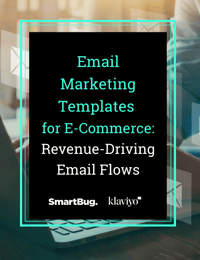
How to Test and Optimize Email Flows in Klaviyo
June 22, 2022
Email flows, also known as email automation, serve as part of the backbone of an e-commerce marketing plan by providing content to subscribers. However, email flows aren’t one-and-done projects. Instead, they require a significant amount of testing based on multiple elements to ensure they are targeting the right audience with the right content at the right time.
In this blog post, we’ll provide you with an approach to testing email flows in Klaviyo that gives you clear answers in order to optimize your emails.
A/B Testing Email Flows
When it comes to testing SMS and email flows, every test falls under one category: A/B testing. This is a user experience experiment that marketers deploy to understand how variations of a campaign perform with split audiences. Simply put, version A of an email is delivered to one half of the audience while version B is delivered to the other half, and then various response metrics are measured to compare the two.
A/B testing is broken down into two categories in Klaviyo:
- Split testing is performed on individual emails.
- Branch testing is performed on entire flow sequences.
As a general rule, you don’t want to spend time testing every email flow. Instead, focus on those that drive the most revenue. For most e-commerce businesses, these include:
- Welcome series
- Abandoned shopping cart
- Browse abandonment
- New customer series
That being said, revenue-driving email flows will vary from brand to brand. Utilize the platform you use to track the success of each email to find those that bring in the most revenue. From there, focus on testing.
Ready to learn how our e-comm marketers can help you? Get in touch!
10 Aspects of a Flow You Should Test
Just like creating a science experiment, testing an email flow requires a hypothesis, variables, and data. No matter which aspect of an email flow is being tested, the A/B testing strategy can be utilized.
The following aspects are common among most e-commerce businesses, but remember, email strategies can look different from one business to another. Be sure you’re not leaving out any that aren’t included below:
1. Entire Flows
Starting at the highest level, determine which flows perform better than others. Do emails that build your brand receive more engagement than those with discounts? Is it the other way around?
Testing entire flows doesn’t always mean you’ll leave one behind for the other. Just because one email includes a great story doesn’t mean your audience doesn’t want discounts from time to time. Instead, use the results as a frame of reference. In flows that include discounts, continue to tell the brand story.
2. Timing
You’ll also want to test the time of day that your audience interacts with your email content. Several factors can contribute to this test, such as demographics, professional position, and age. Keep in mind that your audience might not interact at the same time. In this case, segmenting your audience helps the campaign strategy.
3. Number of Messages
When testing the number of messages, you’re actually testing the audience’s interaction with the messages. If there are too many messages, this can create friction and lower conversion rates. Plus, fewer messages with new content and offers can keep the brand fresh to the audience.
4. Subject Lines
One of the easiest tests to conduct, a subject line test can test a number of strategies. You might want to try a fun or funny subject line versus one that states a relevant statistic. Or, you might test one that creates a sense of urgency against social proof. The same goes for emojis versus no emojis. Which works best?
5. Tone of the Content
Similar to the previous point, testing the tone of the content can provide insight into what really matters to your audience. Do they respond well to cut-and-dry simple content that provides direct action or content that’s educational? Would they prefer something short and witty with a touch of humor?
6. Information Collection
You can never have too much information about your audience, but you do need to be strategic about how you collect it. Test collection information about your audience’s preferences, where they live, and how they use the products at the bottom of an email. Try the same messaging but without collecting the information to see which email performs better.
7. Segmentation
Segmentation is based on information collected from an audience. Based on the specific groups that your audience is segmented into, you can deliver content that is most relevant to their experience as buyers. Sending the same information to different groups can create significant friction.
8. Design and Images
Images and content work in conjunction with one another, but how they are formatted makes a big difference. You might want to try placing the image at the top of the email compared to placing content first. Also, consider the overall design. Does a fancier design work better than a minimalist design?
Try the same thing with other features of the content, such as the coupon. You can also test the amount of the coupon as either a percent or dollar amount.
9. SMS versus Email
SMS marketing and email serve similar purposes, but there are nuances to each. For some companies, SMS might be better for first purchase while a welcome might be better for email. Be sure to always test specific messages to see which does better.
10. Loyalty Programs
Encouraging customers to sign up for loyalty and rewards programs can happen in new customer sequences by showing how many points would be earned with the purchase. However, just like with most aspects of email marketing, this can create friction, so it’s important to determine which segments of your audience, if any, want to see this feature.
Ready to learn how our e-comm marketers can help you? Get in touch!
Optimizing Email Flows
When you think about it, the right testing should also provide your optimization strategy. After running these tests, you’ll want to study the relevant metrics. Pay close attention to the following:
- Open rate
- Click rate
- Placed order rate or conversion rate
- Bounce and unsubscribe rate
Keep in mind that every brand differs, so be sure to include other metrics that are relevant to your business.
From there, the solution is simple: Turn on the email that’s working, and turn the other one off.
It’s good to keep in mind that one A/B test is never the end of testing. Testing should happen consistently and never sit stagnant for more than a few months. Results tend to trend downward after this period. As a general rule, consider optimizing email flows as an ongoing process and ensure that your teams that manage flows are conducting tests on an ongoing basis.
Optimize Email Flows in Klaviyo with E-Comm Experts
Not only is the SmartBug Media e-commerce team of strategists, writers, and designers made up of people who create stellar emails, but we’re also pros with Klaviyo. In fact, we have Klaviyo’s Master Elite status, which means you can know for sure that we can manage and track the performance of your email campaigns to ensure your content is converting.
Want to see more of our expertise at play? Check out our e-book, Email Marketing Templates for E-Commerce: Revenue-Driving Email Flows.
Ready to learn how our e-comm marketers can help you? Get in touch!

A Guide to Getting the Most Bang for Your Buck from Automated Email Flows
Email Marketing Templates for E-Commerce: Revenue-Driving Email Flows
Check It Out
About the author
Ryan O’Connor was formerly SmartBug’s Director of E-commerce Growth, product manager, and sales director. He enjoys helping readers learn how to solve big business challenges through consumer psychology within the constantly evolving e-commerce landscape. Over the past 10 years, Ryan has helped 1000s of DTC brands navigate challenges to grow fast through intelligent marketing. He’s not afraid to get his hands dirty, having launched his own e-commerce stores from the ground up. Read more articles by Ryan O’Connor.



